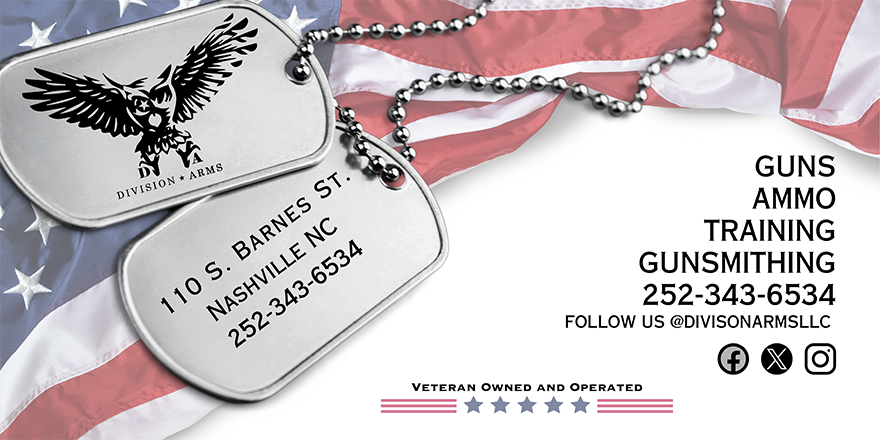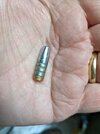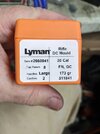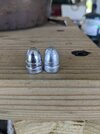You are using an out of date browser. It may not display this or other websites correctly.
You should upgrade or use an alternative browser.
You should upgrade or use an alternative browser.
First casting
- Thread starter Charlie
- Start date
- Replies 48
- Views 2,119
Nice looking projectile ya got there.
It weighs a tad under 180 with the gas check and lube. I am not sure about the alloy. It is a mixture of range lead scrap and old bird shot. I need to get a little more sophisticated with my alloys and hardness testing.Wow. The 311041 has changed over the years. What size does yours drop, with what alloy?
Average Joe
Just A Everyday Joe
2A Bourbon Hound 2024
2A Bourbon Hound OG
Benefactor
Life Member
Supporting Member
Multi-Factor Enabled
Nice looking bullet! Congrats for taking the step. Been wanting to cast for a few years but with my current work and school load, it’s just not in the cards right now. Keep posting updates on your progress and hardness testing.
Sent from my iPhone using Tapatalk
Sent from my iPhone using Tapatalk
I see a powder coat oven in your future. I tried the lube, but after trying PC for the first time, i'll never go back.
Do you do the shake and bake?
I shot some of them today in 30/30, 308, and 30/06. They were wildly inaccurate going all over the place. I assume that was caused by soft bullets. I have no idea how hard they really are except to know they are softer than some of the cast pistol bullets I have bought. I got a Lee hardness tester in the mail today and hope to be able to use it to test the lead I plan to use. Does a Lee tester give good results?
edit: I used the Lee tester on those rifle bullets and came up with a hardness of around 8 - 10. Not good for rifles.
edit: I used the Lee tester on those rifle bullets and came up with a hardness of around 8 - 10. Not good for rifles.
Last edited:
Those ice molds do not melt while in PC oven ? Does the powder coating adhere to the base of the bullet or do you use gas checks ? I've been PCing pistol bullets little over a year and trying to figure a system for rifle bullets. Thanks.I do, and for all of my pistol bullets I just dump them on a screen to bake. Rifle bullets I stand up in mini ice molds like theseView attachment 420318
slow is slow
Insert mysterious title here
They work better than I thought they would. They are silicone so the heat doesn't seem to bother them. I've ran each of mine through the heat cycle probably 50 times and they don't show any sign of wear. A little powder coat here and there will stick to them, but bullets don't ever seem to. I normally dump the whole thing in a bucket of water out of the powder coat oven and then reach in and pull out the ice cube mold. The mold has to sit in a metal tray if you want to move it at all with bullets in it.
- Joined
- Dec 19, 2016
- Messages
- 2,547
I shot some of them today in 30/30, 308, and 30/06. They were wildly inaccurate going all over the place. I assume that was caused by soft bullets. I have no idea how hard they really are except to know they are softer than some of the cast pistol bullets I have bought. I got a Lee hardness tester in the mail today and hope to be able to use it to test the lead I plan to use. Does a Lee tester give good results?
edit: I used the Lee tester on those rifle bullets and came up with a hardness of around 8 - 10. Not good for rifles.
Check the barrel for leading before shooting again. I imagine these soft bullets left some in the barrel.
I use straight clip on wheel weights (COWW) but I don't push them fast. I'm more of a plinker.
I do pushed my 4570 rounds to around 1500 for the 1895 rifle. Sometimes I do water quech the bullets to up their hardness. Water quenching is simply dropping them from the mold to a bucket of water. Of course water and molten lead dont play well together so precautions are taken to ensure that the water that may splash out of the drop bucket can never reach the lead pot.
slow is slow
Insert mysterious title here
Mix in some wheel weights or a little pewter, 8-10 is much too soft for those rifles. You could probably get away with it in a pistol caliber rifle, but not those.I shot some of them today in 30/30, 308, and 30/06. They were wildly inaccurate going all over the place. I assume that was caused by soft bullets. I have no idea how hard they really are except to know they are softer than some of the cast pistol bullets I have bought. I got a Lee hardness tester in the mail today and hope to be able to use it to test the lead I plan to use. Does a Lee tester give good results?
edit: I used the Lee tester on those rifle bullets and came up with a hardness of around 8 - 10. Not good for rifles.
I have been casting some bullets for 9mm and 45. Some come out nice and shiny while some are a bit frosty. The lead is the same. Is temperature the cause of it? I am casting around 850. Is the mold too hot? Does the frostiness harm anything? Thanks
Yep. Too hot. Watch the spur solidify as it cools. Too hot and it will turn solid as it cools and then you can see it frost. Also watch the base of the bullet. If the spur isn't being cut but is ripped out of the base you're too hot. You can see the crystalline structure vs a smooth cut. Watch the nose of the bullets. If too cold you will get wrinkles. Try running your lead at 725 degrees. You can also use a damp cloth to help keep the mould cooler. By the way aluminum or steel mould?I have been casting some bullets for 9mm and 45. Some come out nice and shiny while some are a bit frosty. The lead is the same. Is temperature the cause of it? I am casting around 850. Is the mold too hot? Does the frostiness harm anything? Thanks
Sent from my SM-J320V using Tapatalk
Only thing it hurts is your OCD. They'll go down range just the same.
One caution. Keep water away from molten lead or the tensile fairy shows up. When I said damp towel, just that damp. Nothing more.
Sent from my SM-J320V using Tapatalk
One caution. Keep water away from molten lead or the tensile fairy shows up. When I said damp towel, just that damp. Nothing more.
Sent from my SM-J320V using Tapatalk
Frosted bullets generally shoot fine. Like Grits says, frosting is generally a sign things are running a little hot. Try the 725, and you might slow the casting pace a bit. If you start seeing wrinkles or poor fillout, back up on the changes.
Welcome to the rabbit hole. There's lots of stuff to learn about casting and lots of misinformation. One big one I run into often from beginners trying to make Civil War minies is lead temp. Big bullets require a hot pot and a fast pour for consistent results. I've found minor surface imperfections don't harm performance but varying weight can degrade accuracy. I'm more interested in consistent weight than pretty.
Some of the usual suspects- 40, 45 pistol and 45/70

Civil War minies. The one on the right is a "trashcan" target minie. It can be extremely accurate under 75yds
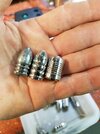
And then there's the standard round ball for my 69cal smooth bore.

And a range of experimental bullets for an 1858 Smith
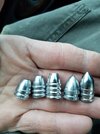
And then we have these guys-
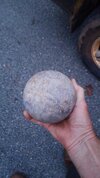
Some of the usual suspects- 40, 45 pistol and 45/70

Civil War minies. The one on the right is a "trashcan" target minie. It can be extremely accurate under 75yds

And then there's the standard round ball for my 69cal smooth bore.

And a range of experimental bullets for an 1858 Smith

And then we have these guys-

ColKurtz
Well-Known Member
2A Bourbon Hound 2024
2A Bourbon Hound OG
Benefactor
Life Member
Supporting Member
Multi-Factor Enabled
Good to see a fellow N-SSA shooter here!Welcome to the rabbit hole. There's lots of stuff to learn about casting and lots of misinformation. One big one I run into often from beginners trying to make Civil War minies is lead temp. Big bullets require a hot pot and a fast pour for consistent results. I've found minor surface imperfections don't harm performance but varying weight can degrade accuracy. I'm more interested in consistent weight than pretty.
Some of the usual suspects- 40, 45 pistol and 45/70
Civil War minies. The one on the right is a "trashcan" target minie. It can be extremely accurate under 75yds
And then there's the standard round ball for my 69cal smooth bore.
And a range of experimental bullets for an 1858 Smith
And then we have these guys-
I agree on casting minie balls. They need a smooth monolithic pour into a very warm mold with pure lead.
I have found the Rapine 415365 to be accurate in my relined Smith. Let me know if you want a few to test out.
I have recently taken the jump to casting modern center fire projectiles after 20 years of casting CW stuff. Quite a bit of differences, but it seems I can easily cover my sins by using powder coat. LOL
Good to see a fellow N-SSA shooter here!
I agree on casting minie balls. They need a smooth monolithic pour into a very warm mold with pure lead.
I have found the Rapine 415365 to be accurate in my relined Smith. Let me know if you want a few to test out.
I have recently taken the jump to casting modern center fire projectiles after 20 years of casting CW stuff. Quite a bit of differences, but it seems I can easily cover my sins by using powder coat. LOL
Whaddaya know? Somebody else who participates in the fun. What team are you on? I've been posting a fair amount over in the black powder section and as a matter of fact, was casting just last night for my 50/70
ColKurtz
Well-Known Member
2A Bourbon Hound 2024
2A Bourbon Hound OG
Benefactor
Life Member
Supporting Member
Multi-Factor Enabled
Manly’s Battery in Tidewater region.Whaddaya know? Somebody else who participates in the fun. What team are you on? I've been posting a fair amount over in the black powder section and as a matter of fact, was casting just last night for my 50/70
Palmetto Sharpshooters, Carolina Region.Manly’s Battery in Tidewater region.
Snoopz
Well-Known Member
I finally got into casting after decades of wanting to make my own bullets. Thirty caliber for some rifles was my first choice. I hope the learning curve is not too steep.View attachment 419457
looking good..... Casting can become a bad habit.
Like the old H&G 68's, here it's been MiHec Brass molds
works of art. cast some nice bullets. The Penta Points have
some great Hollow points (craters)
-Snoopz
I have a bunch of powder coated bullets that I bought a while back and do not really like. Would there be any problems associated with melting them so I can cast the bullets I like? I do not know if the powder coating would cause undesirable things to happen in my melting pot.
Oneofsix
Fur-bearing mammal
2A Bourbon Hound OG
Charter Member
Benefactor
Supporting Member
Multi-Factor Enabled
I would use a smelting pot, not your casting pot to melt them back into ingots and keeping anything undesirable out of the casting pot.
I powder coat my rifle bullets and eliminate the gas caps completely. After powder coating, I resize the bullets for consistency. I have shot these bullets up to 2400 FPS without any problems and don't have to worry about the hardness of the lead. It has taken me 1-2 years to perfect my powder coating technique. I have used a few original ideas but most of my techniques have come from other people.I finally got into casting after decades of wanting to make my own bullets. Thirty caliber for some rifles was my first choice. I hope the learning curve is not too steep.View attachment 419457

